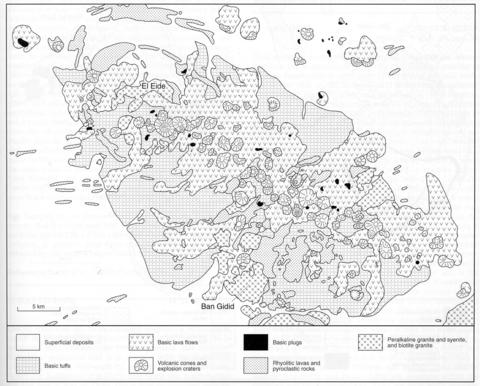stripes
The Main Volcanic Field in the central Bayuda Desert occupies an area of about 50x20 km within which there is an almost continuous volcanic cover, but in the northwest and south the complexes of El Eide and Ban Gidid, which lie beneath the volcanic rocks, are partially exposed. The volcanic rocks reach a maximum thickness of about 200 m and are the products of over 90 eruption centres. The centres generally consist of volcanic cones up to 400 m high typically comprising cinders and ash from which pahoehoe and aa lavas were extruded. Some centres were more explosive destroying the cone and excavating a vent in the underlying basement. Nine such explosion craters have been identified (Barth and Meinhold, 1979), some of them having spectacular craters over 400 m deep. A variety of tuffs and agglomerates were ejected from these centres. The volcanic rocks vary in composition from melabasanite through basanite to nepheline hawaiite (Almond et al., 1984). Modal nepheline has not been observed but all rocks have high normative nepheline (typically 13-16%). They are microphyric with ubiquitous olivine and commonly salitic pyroxene; plagioclase and generally anorthoclase, apatite, biotite or kaersutite are present in the groundmass with pegmatitic patches including clinopyroxene, alkali feldspar and analcime. Chemical data will be found in Almond (1974) and Almond et al. (1984a) while many volcanological details are given by Barth and Meinhold (1979). More than 50% of the Ban Gidid complex is obscured by volcanic rocks. It is a circular structure some 18-23 km across. Peralkaline amphibole granite and hybrid biotite granite form an outer 4-8 km wide shell to the complex. The peralkaline granite is intruded by quartz porphyry dykes which follow the southwest-northeast trend of a dyke swarm in the basement rocks. The central part of the structure is occupied by rhyolitic lavas and pyroclastic rocks. The El Eide complex lies beneath and is partially obscured by the northern margin of the volcanic field. It is 20 km in diameter and forms a multiple ring structure but with substantial areas of basement rocks lying between some of the rings. The core of the complex, of just under 10 km diameter, consists of peralkaline granite, syenite, and quartz syenite and quartz porphyry dykes and is overlain by a thick succession of ignimbrites. Around the core is a ring of peralkaline granite, porphyritic microgranite and biotite granite with broad ring-dykes of quartz porphyry. The outermost ring comprises a dense, arcuate swarm of felsitic and rhyolitic ring-dykes which are only well developed in the north and northwest and separated from the intermediate ring by a wide area of basement gneisses.
ALMOND, D.C. 1974. The composition of basaltic lavas from Bayuda, Sudan and their place in the Cainozoic volcanic history of north-east Africa. Bulletin Volcanologique, 38: 345-60.ALMOND, D.C., KHEIR, O.M. and POOLE, S. 1984a. Alkaline basalt volcanism in northeastern Sudan: a comparison of the Bayuda and Gedaref areas. Journal of African Earth Sciences, 2: 233-45.BARTH, H. and MEINHOLD, K.-D. 1979. Mineral prospecting in the Bayuda Desert. Part 1, Volume A. Investigation of mineral potential. Technical Report Sudanese-German Exploration Project. Hannover (Bundesanstalt fur Geowissenschaften und Rohstoffe). 336 pp. (unpublished) BARTH, H., BESANG, C., LENZ, H. and MEINHOLD, K.-D. 1983. Results of petrological investigations and Rb/Sr age determinations on the non-orogenic igneous ring-complexes in the Bayuda Desert, Sudan. Geologisches Jahrbuch, 51: 1-34.

